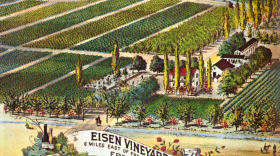Few developments in local history have changed the Valley more than Friant Dam. From providing flood control and irrigation water to the east side of the Valley, to drying up huge portions of the river, and destroying the salmon population, the scale of the dam’s impact is undeniable. Today on KVPR’s Central Valley Roots, we explore the dam’s history.
California leaders originally envisioned the Central Valley Project as a state funded effort as early as 1919. But amid the Great Depression, the state couldn’t sell the bonds necessary to fund construction. Instead the state turned to Washington. In 1935 President Franklin Delano Roosevelt approved the construction of Friant Dam.
With war clouds looming in Europe, construction on Friant Dam formally kicked off on November 5, 1939 for the U.S. Bureau of Reclamation. FDR’s Interior Secretary Harold Ickes was on hand, and delivered a speech comparing the Central Valley Project to France’s Maginot Line.
Contractors the Bent Company and the Griffith Company got the $8.7 million dollar job to build the dam. They had to complete construction in just 1200 days. Some 1500 workers built the structure, earning between $0.68 to a $1.50 an hour. Five workers died on the project in 1940 alone.
The first concrete was poured in summer 1940. Despite America’s entry into the Second World War, the final concrete was poured in June 1942, and the dam began storing water in 1944. At the time, it was the 4th largest masonry dam in the world.






